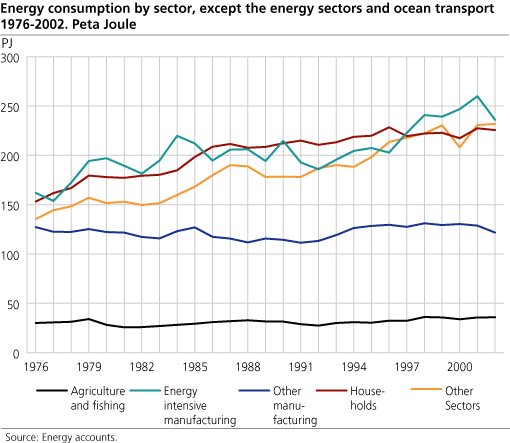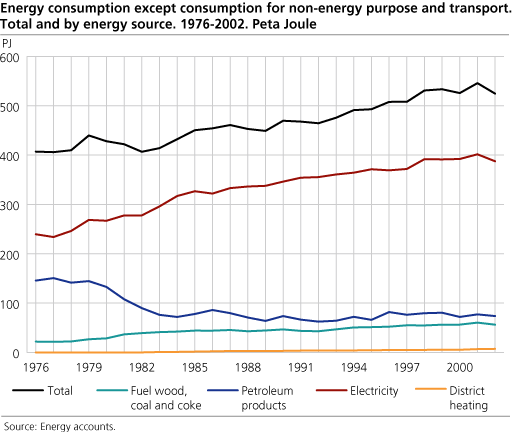Content
Published:
This is an archived release.
Drop in electricity use
Total use of energy fell by 3 per cent from 2001 to 2002 and has not been lower since 1997. The decrease can be attributed to lower energy use in manufacturing industries and the mild weather.
Economic downturn, lower activity levels in manufacturing and a relatively weak growth in the service sector contributed to reduced energy use in Norwegian business and industry in 2002. Manufacturing accounts for almost 40 per cent of the total energy use in Norway, and falling activity levels have a major influence on the total energy use. Manufacturing reduced its energy consumption by 7 per cent from 20011. In the same period, energy use fell by 1 per cent in the service sector while households saw a reduction of 1.3 per cent.
Marked fall in electricity use
Electricity accounts for approximately half of the total use of energy. In 2002 electricity consumption amounted to 108,3 GWh, down 3.5 per cent from 2001. This development can be attributed to the mild weather and a fall in energy use in the first three quarters of 2002. The fourth quarter was colder than normal. A major price jump on electricity at the end of the year made alternative sources of energy more attractive and curbed the increase in electricity consumption.
Electricity prices up, oil prices down
Household electricity consumption fell by approximately 2 per cent from 2001. A more favourable price development for oil than for electricity led to a slight move from electricity to oil. According to quarterly price statistics on electricity, the average electricity price for households was approx. 59.8 øre/kWh. The prices of heating fuels and heating kerosene went down by 8.5 and 6.5 per cent respectively.
Stable oil product consumption
Apart from some variation in individual oil types, total consumption of oil products remained stable from 2001. Consumption of energy for transport purposes increased by just over 1 per cent from 2001 to 2002. Petrol consumption fell by 0.7 per cent and diesel consumption increased by more than 4 per cent, a development that may be related to lower prices on diesel. Table 17 shows the price development for petrol and diesel in 2002.
Lower emissions of greenhouse gases
The use of fossil fuels such as oil and gas results in emissions of greenhouse gases and other contaminating substances. For further information, go to Emissions to air of greenhouse gases. Preliminary national figures, 2002
More information in the StatBank .
1 Emissions to air of greenhouse gases. Preliminary national figures, 2002
Tables:
- Table 1 Energy sources balance sheet for Norway. 2002
- Table 2 Energy balance sheet for Norway. 2002. Petajoule
- Table 3 Energy accounts. Extraction, conversion and use of energy goods. 2002. Preliminary figures
- Table 4 Energy accounts. Use of energy goods outside the energy sectors, by industry. 2002. Preliminary figures
- Table 5 Energy accounts. Extraction, conversion and use of energy goods. 2002. Preliminary figures. PJ
- Table 6 Energy sources balance sheet for Norway. 2001
- Table 7 Energy balance sheet for Norway. 2001. Petajoule
- Table 8 Energy accounts. Extraction, conversion and use of energy goods. 2001
- Table 9 Energy accounts. Use of energy goods outside the energy sectors, by industry. 2001
- Table 10 Energy accounts. Extraction, conversion and use of energy goods. 2001. PJ
- Table 11 Net consumption of individual energy bearers. 1976-2002
- Table 12 Energi balance sheet. 1993-2002. Petajoule
- Table 13 Percentage share of energy consumption, by individual energy bearers. 1983-2002
- Table 14 Energy consumption in householde. 1990-2002
- Table 15 Consumer price index. Total index numbers and subindices for electric energy and other forms of energy. 1979-2002. 1998=100
- Table 16 Average prices and indicies of electric energy for different consumer groups. 1992-2002
- Table 17 Average list prices of selected petroleum products. Excluding and including taxes. 1992-2002
- Table 18 Tax on gasoline. 1975-2003. NOK per litre
- Table 19 Value added tax. 1975-2003. Per cent
- Table 20 Energy consumption as utilized energy. 2002. Petajoule
- Table 21 Calculated prices of utilized energy. 1978-2002. Fixed 1998-prices. øre/kWh. All taxes included
- Table 22 Number of degree-days. 1970-2002
The statistics is now published as Production and consumption of energy, energy balance and energy account.
Additional information
The statistics are published in spring and autumn. The spring publication is preliminary and aggregated to a larger degree, and only includes figures for energy balance. In the autumn publication, tables are also presented for the energy accounts.
Contact
-
Statistics Norway's Information Centre
E-mail: informasjon@ssb.no
tel.: (+47) 21 09 46 42


